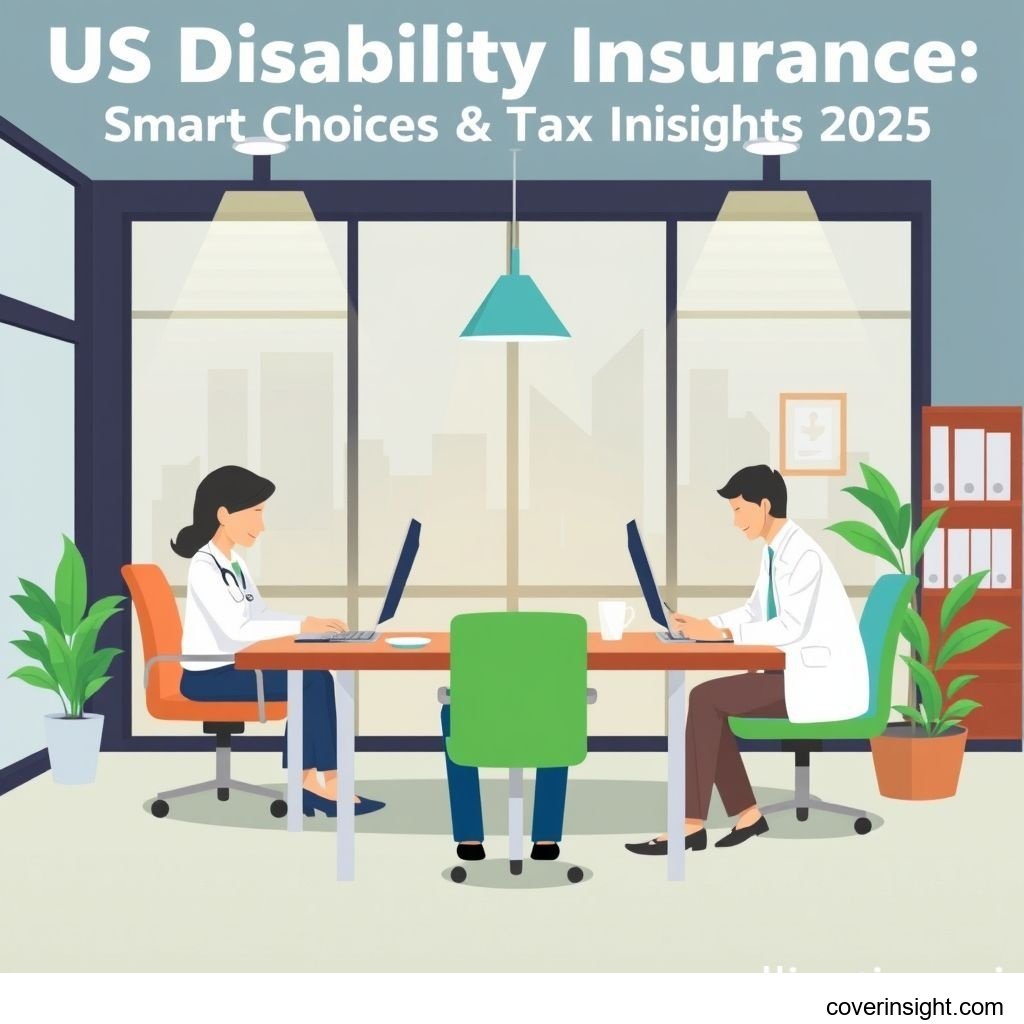Introduction
Navigating the intricacies of US disability insurance can feel like deciphering a complex puzzle, especially when you factor in the crucial tax implications of benefits for 2025. For many Americans, their ability to earn an income is their most valuable asset. But what happens if that ability suddenly vanishes due to an unexpected illness or injury? Disability insurance steps in as a vital financial safety net, providing a portion of your income when you can't work. Understanding how these benefits are taxed – whether fully, partially, or not at all – is paramount for smart financial planning, ensuring you're not caught off guard when it's time to file. It's not just about having coverage; it's about knowing how that coverage truly translates into usable income during a crisis.
Coverage Details
What’s Included
Disability insurance generally covers a percentage of your gross income, typically ranging from 50% to 70%, should you become unable to work due to a covered illness or injury. Policies typically distinguish between "short-term" and "long-term" disability. Short-term policies might cover you for a few months to a year, often with a shorter waiting period (or "elimination period"). Long-term policies, on the other hand, can provide benefits for several years, up to retirement age, after a longer elimination period, commonly 90 days or more. Benefits usually include coverage for a wide range of conditions, from serious accidents to chronic illnesses like cancer, heart disease, or even mental health conditions, provided they prevent you from performing the duties of your occupation. For instance, if you're a construction worker and a back injury prevents you from lifting, or an accountant develops severe carpal tunnel syndrome that stops you from typing, these scenarios would typically trigger benefits.
Common Exclusions
While comprehensive, disability insurance isn't a blank check. Common exclusions often include disabilities arising from pre-existing conditions (unless a waiting period has passed), self-inflicted injuries, acts of war, or injuries sustained while committing a felony. For example, if you knowingly conceal a chronic back issue during your application and then try to claim benefits for it shortly after, your claim might be denied. Policies also typically won't cover injuries sustained during high-risk activities not disclosed or explicitly excluded, such as professional sports or certain extreme hobbies. It's crucial to read the fine print; what one policy covers, another might explicitly exclude. This is where understanding the definitions of "total disability" or "partial disability" within your specific policy becomes vital.
Cost Analysis
Price Factors
The cost of disability insurance premiums is influenced by several key factors. Your age is a significant determinant; younger applicants generally pay less as they are statistically less likely to become disabled. Your health also plays a major role; a clean bill of health will result in lower premiums. The type of occupation you have matters immensely – a desk job, for instance, is considered less risky than a job involving manual labor or hazardous conditions, leading to lower costs. The benefit amount (how much income you want to replace), the benefit period (how long you want benefits to last), and the elimination period (how long you have to wait before benefits begin) all directly impact your premium. Opting for a longer elimination period, for example, can significantly reduce your monthly outlay. Finally, riders—additional features like cost-of-living adjustments or future increase options—will add to your premium.
Saving Tips
Want to keep your premiums from breaking the bank? A few smart strategies can help. First, consider a longer elimination period; delaying benefits for 90 or 180 days instead of 30 can significantly reduce your premium, assuming you have an adequate emergency fund to bridge that gap. Secondly, choose a benefit amount that covers your essential living expenses, rather than attempting to replace 100% of your income. Many financial advisors suggest aiming for 60-70%. Thirdly, inquire about group policies through your employer or professional associations, as these often come with lower rates than individual plans. Lastly, maintain a healthy lifestyle; good health directly translates into lower insurance costs. For a broader perspective on managing insurance costs globally, you might find valuable information at Insurance Resources Global.
FAQs
How much does tax implications of benefits cost?
The taxability of your disability benefits in 2025 hinges on who paid the premiums. If you pay the premiums with after-tax dollars (meaning you've already paid income tax on that money), your benefits are generally tax-free. However, if your employer pays the premiums, or if you pay them with pre-tax dollars (e.g., through a cafeteria plan), then the disability benefits you receive will typically be taxable as ordinary income. For example, if an employer pays a group long-term disability premium for an employee named Michael, and Michael later receives $3,000 a month in benefits, that $3,000 will be subject to federal (and potentially state) income taxes. This is a crucial point many people overlook, only realizing the impact when they start receiving benefits. According to data from the Social Security Administration, over 8.8 million Americans receive Social Security Disability Insurance (SSDI), and while SSDI has its own tax rules based on other income thresholds, private disability benefits operate under these premium-payment rules. Always consult a tax professional for personalized advice.
What affects premiums?
As mentioned earlier, premiums are largely affected by your age, health status, occupation (risk level), the amount of coverage you choose, the length of the benefit period, and the duration of the elimination period. Your gender can also sometimes play a role, as can any optional riders you add to your policy. To get a detailed understanding of how these factors might apply to your situation, you can consult your State Insurance Departments for local regulations and consumer guides.
Is it mandatory?
No, private disability insurance is generally not mandatory in the US. However, some states, like California, New York, and Hawaii, have state-mandated short-term disability insurance programs (State Disability Insurance, or SDI) that provide basic benefits. For most individuals, particularly those who are self-employed or whose employers don't offer comprehensive group plans, purchasing an individual long-term disability policy is a personal decision, albeit a highly recommended one for financial security.
How to choose?
Choosing the right disability insurance involves several steps. First, assess your income and essential expenses to determine how much coverage you truly need. Next, research different types of policies, paying close attention to "own occupation" versus "any occupation" definitions of disability. "Own occupation" is generally more favorable as it pays if you can't perform your specific job, while "any occupation" only pays if you can't perform any job for which you are qualified. Compare quotes from multiple providers. Look into their financial stability and customer service reputation via resources like the National Association of Insurance Commissioners. Consider what riders might be beneficial for your specific situation. Don't be afraid to ask questions and seek guidance from a qualified insurance professional. For a comprehensive overview of your options, including health insurance resources often intertwined with disability planning, Healthcare.gov can also be a useful starting point for understanding your overall health coverage landscape. For more specific local information, you can always visit US Insurance Home.
Consequences of no coverage?
The consequences of not having disability insurance can be dire. Without a safety net, an unexpected illness or injury could lead to a catastrophic loss of income, forcing you to deplete savings, rack up debt, rely on family, or even face bankruptcy. In 2022, the U.S. Census Bureau reported that 7.6% of people in the U.S. had a work-limiting disability, underscoring the real and present risk. Consider the case of Mark, a software engineer from Seattle, who suffered a severe stroke at 45. Without disability insurance, his family would have faced immense financial strain, potentially losing their home and quality of life as medical bills piled up and his income vanished. His employer-provided short-term disability covered only 3 months, leaving a vast gap that only a robust individual long-term policy could have filled.
Based on my experience living and working in the US, I've seen firsthand how unexpected health issues can turn lives upside down. We often prioritize insuring our homes and cars, but somehow, protecting our income – the very engine that drives all our other assets – often takes a back seat. It's easy to think "it won't happen to me," but the statistics paint a different picture. Investing in disability insurance isn't just a financial decision; it's an act of self-preservation and a profound gift of peace of mind to yourself and your loved ones. Don't leave your financial future to chance; take a serious look at how disability insurance can fortify your family's financial foundation.
Further reading: Insurance Resources Global
Further reading: US Insurance Home








Comments